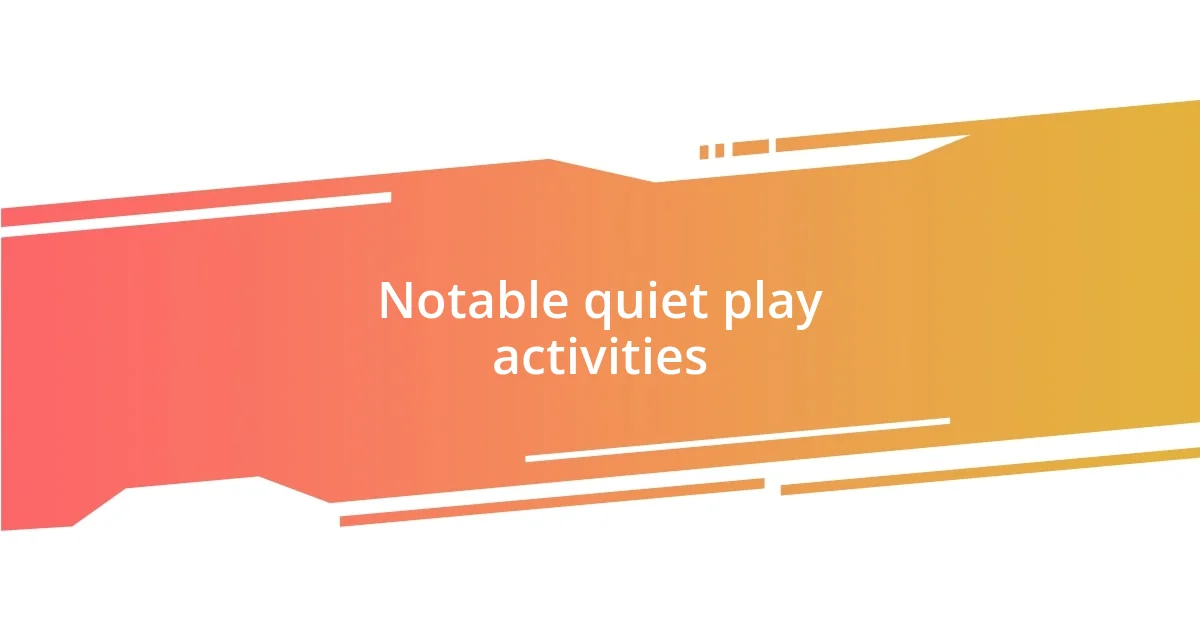Key takeaways:
- Quiet play significantly enhances children’s emotional and cognitive development, fostering creativity, independence, and self-regulation.
- Creating a soothing play environment with themes, sensory materials, and flexible timeframes deepens children’s engagement and imagination during quiet play.
- Observing children during quiet play reveals their social skills, problem-solving abilities, and emotional intelligence, highlighting the importance of unstructured play in their growth.

Understanding quiet play benefits
Quiet play has a profound impact on children’s emotional and cognitive development. I’ve noticed that when my child engages in activities like coloring or building with blocks, it not only sparks creativity but also fosters a unique sense of independence. Have you ever watched a child become completely absorbed in their own world? It’s almost magical to see how quiet play allows their imaginations to flourish, leading them to explore scenarios and ideas at their own pace.
From my experience, quiet play also serves as a wonderful way for kids to practice self-regulation. I remember a time when my daughter was feeling overwhelmed after a busy day. Instead of pushing her to interact, I suggested a simple puzzle. Within moments, her focus shifted, and it was as if I could see her emotions settle with each piece she placed. This made me realize how important it is to create space for them to decompress and recharge.
In essence, the benefits of quiet play extend far beyond mere entertainment; they are essential for nurturing a child’s ability to think critically and focus intently. During these serene moments, I find that children learn to navigate their thoughts and feelings better. It’s almost as if quiet play offers them a safe haven, where they can process their day and discover new ideas without external pressures.

Techniques for engaging quiet play
Engaging in quiet play can be truly enriching for children, and I’ve found that introducing themed play areas can enhance their focus significantly. For instance, I once set up a “nature corner” with soft fabrics, toy animals, and some potted plants. My child was instantly drawn to it, spending hours creating stories about the animals and their adventures. This not only encouraged imaginative play but also helped them connect with nature in a calming, yet interactive manner.
Another technique that’s worked wonders is incorporating sensory materials into quiet playtime. I remember setting up a tray with rice, small cars, and scoops for my son. The tactile experience captivated him, and I watched him explore and experiment effortlessly. The serene nature of the activity not only kept him engaged but also fostered fine motor skills as he maneuvered the vehicles. It surprised me how such simple additions could transform a quiet play session into a rich learning experience.
Ultimately, having flexible timeframes for quiet play sessions can lead to deeper engagement. I’ve learned not to set a strict duration but rather to observe when my child is fully absorbed. During one afternoon, I chose to step back and let her play with building blocks for as long as she wanted. In doing so, I noticed her creativity flourish beyond what I typically witnessed in short bursts of play. Sometimes, it’s about giving them the space and time to truly immerse themselves in their own imaginative worlds.
| Technique | Description |
|---|---|
| Themed Play Areas | Setting up specific areas with a theme can inspire creative storytelling and imaginative play. |
| Sensory Materials | Using materials like rice or sand allows for tactile exploration, enhancing focus and fine motor skills. |
| Flexible Timeframes | Allowing children to decide how long they engage in quiet play can deepen imagination and creativity. |

Creating a quiet play space
When creating a quiet play space, I’ve found that simplicity truly reigns supreme. While brainstorming space design, I recall considering the colors and arrangement of toys. My daughter has been especially fond of a cozy nook filled with soft cushions and a few favorite books. This arrangement not only sparks her interest but also allows her to feel secure and comfortable while she delves into her imaginative worlds.
To create an optimal quiet play environment, here are some key aspects to consider:
- Soft Lighting: Use natural light or soft lamps to create a calming atmosphere.
- Comfortable Seating: Incorporate cushions, bean bags, or blankets for a snug play area.
- Limited Distractions: Keep toys and materials organized and avoid overwhelming displays.
- Variety of Materials: Offer a mix of books, puzzles, and craft supplies to stimulate creativity.
- Quiet Sound: Play gentle background music or white noise if needed, but keep it subtle.
I remember the difference it made when I added a small rug in that nook. The moment I laid it down, my child curled up with her stuffed animals and began enacting little stories. The rug seemed to define her space, offering her that extra layer of comfort and security. It’s amazing how such small details can transform a corner of your home into a magical retreat for quiet exploration.

Notable quiet play activities
I’ve experienced profound moments of connection during quiet play with simple activities like coloring or drawing. I remember one rainy afternoon, I laid out some paper and crayons on the dining table. As my child focused on filling the page with colors, I watched her face light up with each stroke. It was heartwarming to see her immerse herself in that colorful world, allowing her creativity to flow freely without the interference of screens or noise. Isn’t it interesting how something as basic as coloring can provide a canvas for self-expression and imagination?
Puzzles have also transformed our quiet play sessions. I recall introducing a wooden puzzle that featured animals, and my little one was fascinated. As she worked on fitting the pieces together, there was a silent determination in her eyes, followed by bursts of excitement with each successful match. This activity not only sharpened her problem-solving skills but also fostered a sense of accomplishment each time she completed a puzzle. Can you think of a time when a simple activity brought your child such joy?
Another remarkable quiet play activity I’ve embraced is storytelling through puppetry. I remember crafting puppets from old socks and felt, and it became a delightful way to narrate bedtime tales. As my child animated the characters, I noticed her enthusiasm blossom into captivating stories that often surprised me. Each puppet had its own personality, and it made the storytelling experience so much richer. Does your child have a favorite way to tell stories that brings them joy? Engaging in this kind of play nurtures not only creativity but also strengthens the bond we share through shared narratives.

Observing child interactions
Observing children interact during quiet play has been a treasure trove of insights for me. I still remember that afternoon when my little one was deep in concentration, building with blocks beside a friend. Their laughter was infectious, but what stood out was how they communicated non-verbally, exchanging glances and gestures to share ideas. It struck me how even at a young age, children possess an innate ability to collaborate without words. Have you noticed this kind of silent dialogue in your child’s play?
I’ve found that moments of conflict during these interactions can be just as enlightening. One time, I watched my daughter and her friend argue over who got to play with a particular toy. Instead of stepping in immediately, I observed how they navigated their feelings. They expressed their needs and, by the end, reached a compromise that surprised me. Their resilience and problem-solving skills blossomed right there in that moment, which makes me wonder: do we sometimes underestimate their capability to resolve issues independently?
Moreover, witnessing the fluidity of roles during play is quite revealing. I recall a time when my child decided to be the “teacher” in a make-believe classroom with her stuffed animals. As I watched her guide them through a story, it was fascinating to see her experiment with authority and patience. Her leadership style emerged in those moments, giving me a glimpse into her understanding of social dynamics. It makes me ponder: how might these playful interactions shape their approach to teamwork as they grow? Each observation enriches my understanding of their developmental growth.

Reflecting on learning outcomes
Reflecting on the learning outcomes of quiet play reveals just how much growth happens outside formal settings. I recall a serene afternoon where my child and I built a fort using cushions and blankets. As she draped the fabric over the furniture, I noticed her problem-solving skills in action—figuring out how to create a stable structure. This simple act of building not only deepened her spatial awareness but also fostered her ability to think critically while having fun. Have you noticed similar skills emerging in your child during play?
I’ve also come to appreciate the emotional depth that quiet play can cultivate. One day, my child chose to play alone with her dolls, assigning each one a distinct personality and storyline. I stood back and watched as she navigated complex emotional scenarios, from friendship dilemmas to cooperative challenges. It touched my heart to see her empathize with each character’s feelings, highlighting her emotional intelligence at such a young age. Isn’t it fascinating how play can serve as a safe space for children to explore their own emotions?
Moreover, I often reflect on how quiet play sparks creativity and innovation. I once encouraged her to imagine a new game with her toys. It was incredible to see her brainstorm rules and invent unique challenges. The joy in her eyes as she created something from nothing was enchanting, and it made me realize that quiet moments can lead to profound bursts of creativity. How do you think these instances of imaginative play contribute to your child’s ability to innovate in other areas of life?















